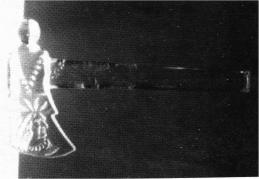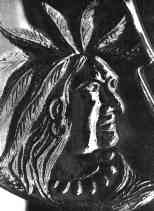That Elusive Tomahawk
by Joseph A.A. Bourque Sr.
Issue 292 - August 1997
Dear Reader,
 Figure 1 Figure 1 |
|---|
| No. 2561 Tomahawk. Packed 18 doz. in a bbl. |
This month's topic will be about a Nearcut Novelty, the No. 2561 glass tomahawk. Just after the turn of the century, Cambridge Glass made this small glass axe.
The Cambridge Glass Company's Glass Tomahawk. It is 7" long with a 4 blade. This one is of clear glass. The blue glass one in iridescent purple Carnival is rare and expensive. Do you know its listed value?
In their 1903 Catalog, this novelty item is shown on Page 43 (Bennett's reproduction of this catalog). Apparently, this image was artist drawn, and did not depict the true particulars of the finished product. In order for the reader to be able to better identify this item, examine the catalog sketch (Figure 2), and compare it detail for detail against the photographic enlargement of the Indian Chiefs head. (Figure 3) The following details differ:
- all eight feathers
- forehead
- eyes
- nose
- lips
- chin
- neck charms
- hair
- clothing at "V" neck
 |
|---|
| Figure 2 An artist's sketch of what the Cambridge Glass tomahawk looks like. Compare this with an enlarged photograph for true details. |
If you do not have a glass tomahawk made from a Cambridge mold, study the specifics within the blown-up photograph to give you an idea of what the product of an original mold would look like.
 |
|---|
| Figure 3 This is what the Indian Chief from a Cambridge mold tomahawk looks like. If you find one in Carnival Marigold, what should you pay for it? Study the chiefs detailed features should you run across one. Reproductions from Cambridge Glass Company molds look like this, but fakes have far less details. |
If the top of the handle has chips on it, this is no cause for alarm as most tomahawks are chipped in this location. From appearances, the mold that formed these axes made at least two at a time, their being joined at the top of the handles by a thinner rod of glass. When the joined sets cooled, a glassworker simply grasped the tomahawk handles and snapped them apart. The chipped ends were then put against a grindstone to smoothen out the top of the axe. Because of this separating process, some chipping took place on top of the blade and left marks. Some of these chip marks were too low and/or deep. It would not have been feasible to remove them. I have a glass axe that broke off fairly clean and has never been ground, showing nothing but chips atop the handle.
Be advised that this tomahawk item, even though made from an original Cambridge Glass Company mold, has been reproduced in various colors.
The most elusive glass tomahawk is a blue-based Carnival one, having purplish iridescence, made by the Cambridge Glass Company of Cambridge, Ohio. It is much sought-after by Carnival and Cambridge glass collectors. Its value is listed at $1,850. Should you see one in that less desirable color of Marigold, don't pass it up if the price is right, as it lists at $400.
Do you old-timers remember the $5- and $6-priced Carnival tomahawks you may have passed up decades ago? I do ... and more than once!
Happy Triangle-C Finds,
Joe
EDITORIAL NOTES: (from Crystal Ball issue #293) Regarding the Tomahawk, the topic of the Triangle-C Finds column in the August 1997 issue of the Crystal Ball.
It was brought to my attention by a member that the tomahawk was actually owned and made by Degenhart. Caution should be taken in purchasing tomahawks to insure that you are purchasing a Cambridge (or Degenhart) tomahawk.
